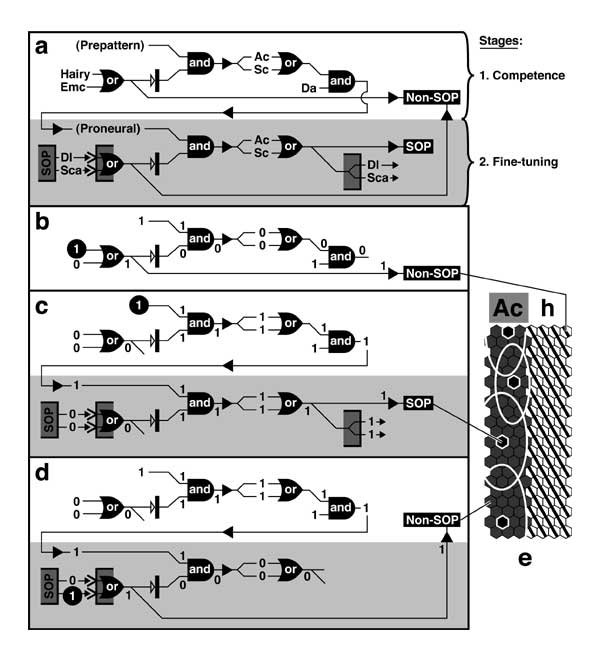Select image to enlarge

Figure 3.13
Circuitry that assigns SOP (bristle) vs. non-SOP (smooth cuticle) cell fates in the epidermis (cf. Fig. 2.7 for key to symbols).
a. Core pathway of proteins that decide SOP vs. non-SOP identities (see text for further details). Abbreviations: Ac (Achaete), Da (Daughterless), Dl (Delta), Emc (Extramacrochaetae), h (hairy), Sc (Scute), Sca (Scabrous). In the first stage, prepattern factors (cf. Chs. 5 and 6) prompt the synthesis of Ac and Sc in certain regions by acting through cis-enhancers in the AS-C (Fig. 3.4). When Ac and Sc (which act redundantly) heterodimerize with Da (which is ubiquitous; Fig. 3.12), they endow a cell with the competence (Fig. 3.2) to become a SOP. This proneural state can be prevented by the antineural agents Hairy (which primarily affects Ac) and Emc, both of which act intracellularly (Fig. 3.12). In the second stage (shaded), one or more SOPs are selected by fine tuning (Figs. 3.3, 3.6-3.9) within the proneural field. Continued accumulation of Ac and Sc prods a cell to become a SOP, unless it is blocked by external antineural signals emitted by SOPs themselves (Fig. 3.6). Dl and Sca are thought to be short- and long-range agents respectively (see text) that create an inhibitory field around each SOP.
b-e. Schematics of cells (b-d) that are selecting various fates at different tissue locations (e). States of components (cf. a) are recorded as 1 (present) or 0 (absent), and black circles denote determining factors. b. The circuit as it functions in areas where Hairy is expressed (e.g., leg stripes, e). The cell never becomes competent because Hairy is the controlling factor. c. If a cell is impelled by prepattern factors (circled '1') and no antineural agents are present, then it will complete the gauntlet and become a SOP. d. Any cell inside the inhibitory field of a SOP cannot become a SOP. Sca (circled '1') is here assumed to be the diffusible inhibitor. e. Rectangular piece of leg skin (Fig. 3.9c) containing one Ac stripe (shaded) and the adjoining Hairy interstripe (hatched). Among these ~150 cells (hexagons), only 4 SOPs (black cells, c) will form. Remaining cells are prevented from becoming SOPs because they contain Hairy (b) or are inhibited by a nearby SOP that adopted this state (stochastically) before they could do so (d). Ovals mark limits of inhibitory fields, which are assumed to be anisotropic because the inhibitor (Sca?) does not diffuse freely.
N.B.: In D. melanogaster, non-SOP cells look alike, regardless of whether they were previously proneural, but other species convert some proneural fields into pigment stripes [615]. Although the circuitry depicted here is digital, the 'SOP computer' actually operates partly in an analog (threshold) mode (Fig. 3.12; see text). Also, it is not known whether Sca acts via the same pathway as Dl [113], and other questions remain about the core logic [178]. In principle, the 'AND' gate preceding Ac and Sc should cancel out the subsequent 'OR' gate, but this part of the circuit is included because Ac and Sc can be independently changed by mutations (Fig. 3.5) or various LOF-GOF manipulations (App. 5).
|
|
